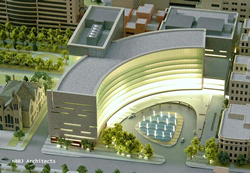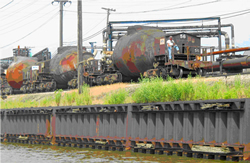
Cleveland can capitalize on the presence of leading medical and educational institutions to attract bio-medical and information technology businesses. [Cleveland Clinic Heart Center] | ECONOMIC DEVELOPMENT
GOAL: Increase economic prosperity through job creation and improved access to jobs and business ownership by all segments of the Cleveland community
Issues
During the first half of the 20th century, Cleveland?s economy boomed in an era when the steel industry was king.? Workers from Europe and later from the rural south flocked to Cleveland to find work and to raise families.? Many of these manufacturing jobs paid well and required relatively little education.
?Today, another wave of opportunities is rolling in, except that this time the revolution is taking place in knowledge-based occupations.? Cleveland is well positioned to capture a significant share of these jobs, given the region?s assets in world-class medical institutions and universities, as well as its legacy of manufacturing know-how.? Cleveland?s challenge is to re-tool its industries and re-educate its workforce to compete in this knowledge-based economy.? Cleveland also has an historic opportunity to create the vital urban neighborhoods ? ?neighborhoods of choice? ? capable of attracting individuals with the education and talent to fuel those knowledge-based businesses.
?Nationally, the most prosperous regions are those that radiate out from strong, vibrant central cities.? Likewise, it is not an oversimplification to state that northeast Ohio will prosper in the 21st century only if Cleveland prospers.? For Cleveland and its region to prosper, both must focus on expanding the economic base ? not merely shifting jobs from one part of the region to another, but creating wealth by growing and attracting businesses that export goods and services outside the local economy. |

Despite long-term job losses, heavy manufacturing remains a vital part of Cleveland?s economy. [train at Mittal Steel plant on Cuyahoga River.] |
Policies
- Health Care Commerce. Capitalize on the presence of world-renowned medical and educational institutions to grow businesses involved in health care procedures and products, while attracting patients and visitors from outside the region.
- Advanced Manufacturing. Promote product design, product innovation and productivity process improvements to help industry shift from traditional production to higher-value and specialized output in sectors where Cleveland can create competitive advantages.
- "Center of the Center". Strengthen the amenities, attractions, businesses and residential environment in the central city and its downtown as a keystone for regional economic growth.
- Learning. Strengthen public education and access to lifelong workforce learning opportunities as a foundation for building a globally competitive economy and personal prosperity for Cleveland residents.
- Opportunity and Equity. Ensure that all Clevelanders have the opportunity to benefit from local economic development activity.
- Infrastructure . Plan long-term, coordinated improvements in roadways, transit, waterways, fiber and other infrastructure to foster retention and expansion of the economic base.
- Adaptive Re-Use . Bring back into productive economic use advantageously located vacant properties and brownfield sites.
- Eco-Industry. Make Cleveland a national leader in the development and application of green building, environmental remediation, alternative energy and sustainability technologies.
- Land Assembly. Assemble freeway-accessible sites large enough to accommodate industrial and office park development.
- Regionalism. Promote the region?s broad range of business assets in competing collectively to attract businesses from beyond our regional economy.
- Incentives. Use pubic financial incentives in proportion to the resulting local economic benefits, while ensuring that assistance program meets the full range of capital needs.
- "Hassle Factor". Make it easier and more predictable to do business in and with the City by implementing a customer-focused approach to regulation and approvals and by providing incentives in a manner that is transparent and easy to navigate.
- Quality of Life. Create vibrant urban neighborhoods capable of attracting individuals who will fuel entrepreneurship and "new economy" businesses.
- Arts and Culture. Utilize the arts and cultural offerings to attract highly talented and skilled individuals to live and work in the city.
|





